

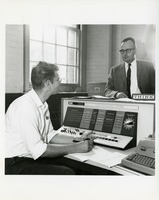
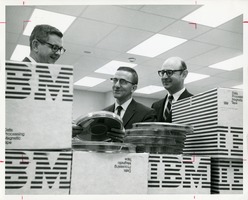
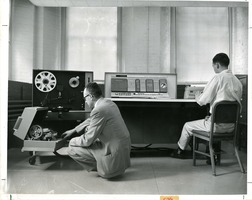
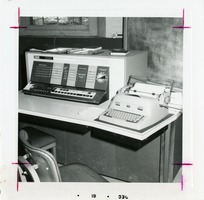
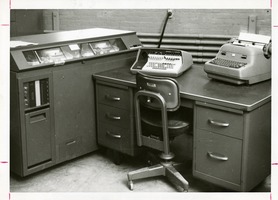
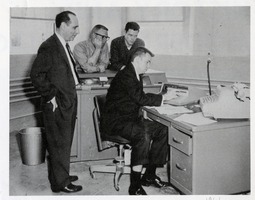
When I arrived at WPI in 1964, the "academic" computer was run by the math
department and was in the basement of Stratton. The computer was an IBM
1620. It was managed by math grad students. It was card-in/card-out and had
no disk. If you wanted to see your output, there was an IBM "interpreter"
which would accept the deck and make a printout. There were 2 senior-year
undergraduate computer courses: MA 441 and ME 441; the former for math
problems, the latter for engineering. For some reason, there was a short
Fortran introduction as part of freshman ROTC, which is where I encountered
computing for the first time. I became consultant for my dorm floor and
hung around the computer center until they made me the first undergraduate
employee of the computer center. After a year or two, they added a disk
drive. The decimal machine initially had 20000 digits of memory, but was
upgraded to 40000.
WPI's registration system was written in machine language on that 1620 by
Walter Kistler (an ME grad student at the time). Patching and updating that
thing must have been a misery.
In 1967, WACCC was formed and the computer was installed in the basement of
Gordon Library. WACCC paid the library rent for the space. It was
"Worcester Area College Computer Center", since it was supposed to serve
the area colleges, the computer having been purchased by a grant for that
purpose. The computer was an IBM 360/40. It was card-in/print-out. It did
have a punch, if someone needed to carry data for later input. It generally
ran DOS (the Disk Operating System), but occasionally was brought up under
Operating System (a timesharing sort of system). Operating System was
massively more overhead than DOS, and a 360/40 was not killer fast. It was
probably cramped for memory, but I don't recall the number.
I found out some time later that other administrative processes had been
run on an IBM 1401 in the basement of Boynton. Later, I found that the
admin system had been moved under the bleachers of Harrington (field
side). I do not recall the brand or model. Some years after WACCC was
established, that group moved, with their computer, into the Gordon Library
space. Their functions eventually moved to the WACCC administrative
computer, joining with the registration system which had been
re-implemented in COBOL.
When I graduated BS ME '68, there was no CS at WPI. I had a job at IBM, but
was drafted instead, and returned to WACCC in 1970 when CS was grad-level
only. I took CS classes in the classroom in WACCC. I think some professors
had offices at the WACCC level. At this point, the 360 was gone and there
was an RCA 70/46. It was marketed as the "octoputer"; an image of tentacles
leading out to computer screens. I recall its 1400 card a minute reader,
which would leave burn marks across cards if they were put through a number
of times. It was EBCDIC, like the 360. I believe the instruction set was
the same, too. It had this new thing: virtual memory. Students had card
access to this, but administrative systems had terminals. None of the
terminals were outside of WACCC.
RCA got out of the computer business and the product line was taken over by
Sperry. There was a story that there was an accounting error, and RCA
computers actually were profitable, but they just didn't know it. Their
vacated buildings in Marlboro were taken over by Digital. A Sperry 90/60
was installed as an upgrade to the 70/46 some years later. I don't recall
when that happened.
The Digital PDP-10 was acquired for academic timesharing around 1971, and
that was my responsibility. It was a KA-10, which had "flip chips". Those
were transistor circuit boards of a standard size which plugged into the
bus. It had a 36-bit word size, so there was no IBM compatibility
here. Initially, it had 96K words of memory, but 64K was added later. In
later years it was marketed as a DECSYSTEM-10. This was a terminal-access
computer. No cards any more. Students had their own logins, which were PPNs
(Project/Programmer Numbers). Those numbers are similar to the GID and UID
which are behind alphabetic UNIX logins. I had to write a disk-oriented
login management program, since the Digital-supplied one had to have all
the account information in memory. The sources were provided for all the
software. If we had a problem with software, we'd fix it and report to
Digital. All of a program had to be in memory for it to run. I.e. it was
not virtual memory system. There was an "impure" low segment, unique to the
process, and possibly a "pure", shared high segment. In later years, we
decided to make improvements. A student, Greg Walsh, rewrote the disk
service. I rewrote the terminal service. Another student rewrote the
scheduler. Some students who graduated and got jobs using KI-10's (KI the
next generation, meant "Integrated Circuit"), said that the WPI KA-10 ran
better than a standard KI. Of course, hacking the central academic resource
of the campus was something that could never happen today. I don't know if
CS offers students this sort of environment, but I think that the students
who worked at WACCC in the '70's had a good experience.
The KA-10 was replaced by a KL-10, running DECSYSTEM-20, a virtual memory
operating system. Operating System sources were not provided, but we must
have had application sources, since I hacked the linker to include symbols
with the binary and Eric Hahn developed a program IDDT ("invisible" DDT) so
that programs could be debugged without altering their memory. Digital's DDT
(Dynamic Debugging Technique) dragged in all the symbols and well as DDT
itself into your binary which altered things so much that it was often hard
to debug your program. He also developed a "freeze/thaw" mechanism where
you could store away your process and come back to it at some later time to
continue it. Eric’s MQP was describing a packet switched terminal network,
which he called VTN (virtual terminal network). He graduated and started at
BBN in Cambridge and he would travel back to WPI weekends and we worked on
implementing his model on hobby equipment. A node had a CPU card, memory,
and a number of serial I/O cards. A vendor made 4 port serial boards with
on-board CPU and small amount of memory. The main CPU would grab data from
the cards and shift it where it needed to go. VTN was the campus network
for a number of years. The nodes interconnected over serial lines at 19.2k
baud over one of the same 4 port I/O cards.
Greg Walsh lured Eric Hahn from BBN to Silicon Valley. They have done very well.